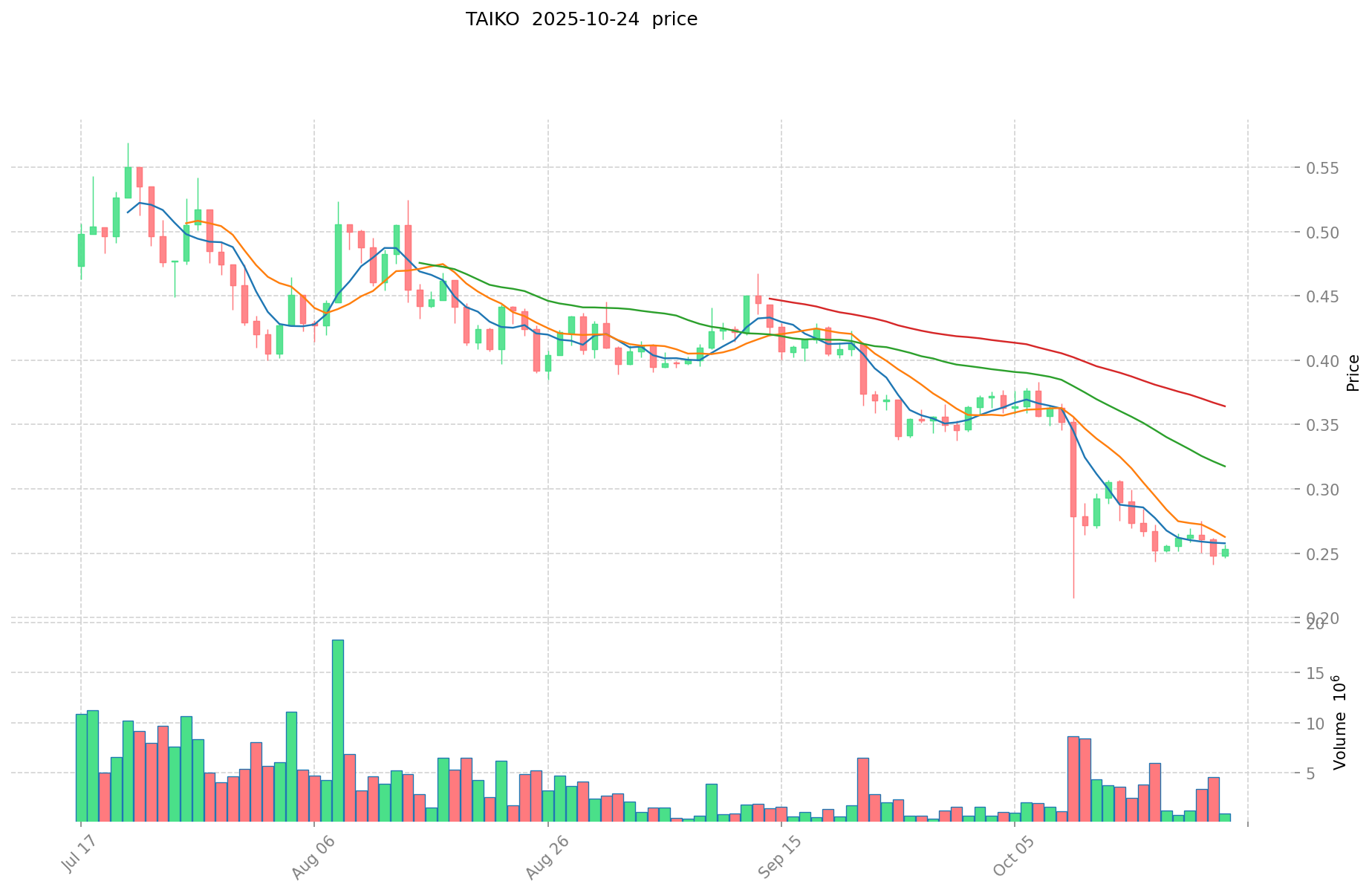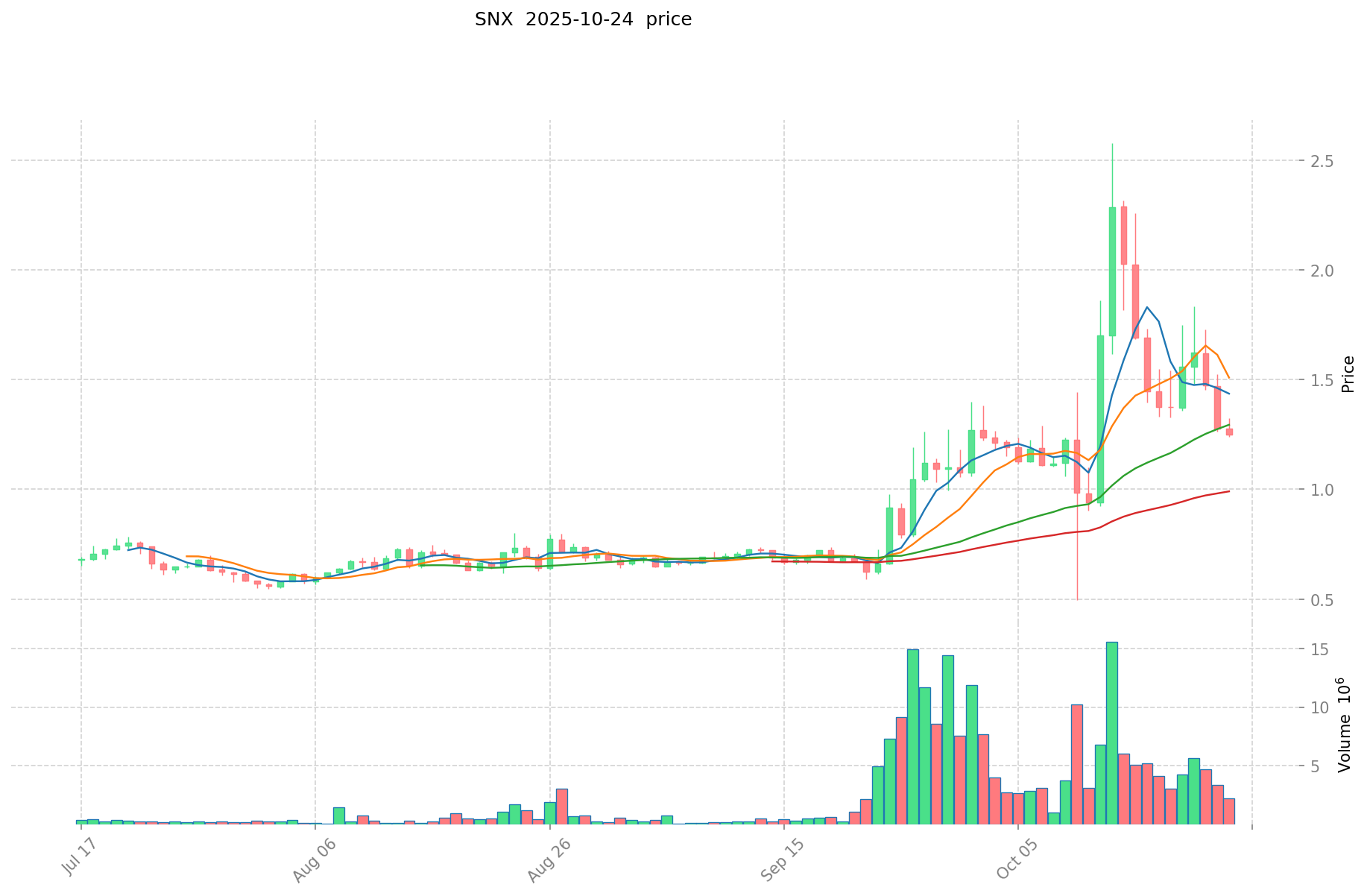TAIKO vs SNX: Comparing Layer 2 Scaling Solutions for Ethereum
Introduction: Investment Comparison of TAIKO vs SNX
In the cryptocurrency market, the comparison between Taiko vs Synthetix has always been an unavoidable topic for investors. The two not only have significant differences in market cap ranking, application scenarios, and price performance, but also represent different positions in crypto assets.
Taiko (TAIKO): Since its launch, it has gained market recognition for its position as an Ethereum L2 scaling solution.
Synthetix (SNX): Since its inception in 2018, it has been hailed as a platform for creating synthetic assets, and is one of the leading projects in decentralized finance (DeFi).
This article will comprehensively analyze the investment value comparison of Taiko vs Synthetix, focusing on historical price trends, supply mechanisms, institutional adoption, technological ecosystems, and future predictions, and attempt to answer the question most concerning investors:
"Which is the better buy right now?"
I. Price History Comparison and Current Market Status
TAIKO and SNX Historical Price Trends
- 2024: TAIKO reached its all-time high of $4.126 on June 6, 2024.
- 2025: SNX experienced a significant decline, dropping 83.07% over the past year.
- Comparative analysis: In the recent market cycle, TAIKO dropped from its high of $4.126 to a low of $0.215, while SNX declined from $28.53 to its current price of $1.2449.
Current Market Situation (2025-10-24)
- TAIKO current price: $0.2518
- SNX current price: $1.2449
- 24-hour trading volume: TAIKO $235,163.71 vs SNX $2,942,763.98
- Market Sentiment Index (Fear & Greed Index): 27 (Fear)
Click to view real-time prices:
- View TAIKO current price Market Price
- View SNX current price Market Price


II. Core Factors Affecting TAIKO vs SNX Investment Value
Supply Mechanism Comparison (Tokenomics)
- TAIKO: Low circulating supply (1.2 billion) with high FDV (19 billion), suggesting significant future token release pressure
- SNX: Higher token circulation ratio similar to established DeFi protocols, with lower future selling pressure
- 📌 Historical pattern: Projects with high FDV to circulating supply ratios typically experience price suppression during token unlock periods
Institutional Adoption and Market Applications
- Institutional holdings: SNX benefits from being an established DeFi protocol with mature tokenomics and governance
- Enterprise adoption: TAIKO positions as an Ethereum Layer 2 scaling solution with potential for broad application, while SNX serves as a decentralized credit market infrastructure
- Regulatory stance: Layer 2 solutions like TAIKO face less regulatory scrutiny than synthetic asset platforms like SNX which may encounter more regulatory challenges
Technical Development and Ecosystem Building
- TAIKO technical progress: Recently activated binding on-chain governance system and appointed three board members, strengthening its governance structure
- SNX technical development: Established protocol in the DeFi credit market with proven market fit
- Ecosystem comparison: TAIKO contributes to Ethereum's scalability while SNX provides foundational infrastructure for decentralized finance applications
Macroeconomic Factors and Market Cycles
- Inflation environment performance: Established DeFi protocols like SNX have demonstrated historical resilience during market downturns
- Macroeconomic monetary policy: Both projects benefit from increased DeFi adoption during periods of traditional financial uncertainty
- Geopolitical factors: Growing demand for decentralized financial infrastructure benefits both projects, with SNX potentially seeing more immediate impact
III. 2025-2030 Price Prediction: TAIKO vs SNX
Short-term Prediction (2025)
- TAIKO: Conservative $0.17-$0.25 | Optimistic $0.25-$0.31
- SNX: Conservative $1.18-$1.24 | Optimistic $1.24-$1.69
Mid-term Prediction (2027)
- TAIKO may enter a growth phase, with prices estimated at $0.23-$0.43
- SNX may enter a consolidation phase, with prices estimated at $0.92-$2.13
- Key drivers: Institutional fund inflows, ETF, ecosystem development
Long-term Prediction (2030)
- TAIKO: Base scenario $0.30-$0.47 | Optimistic scenario $0.47-$0.49
- SNX: Base scenario $1.89-$2.10 | Optimistic scenario $2.10-$2.17
Disclaimer
TAIKO:
| 年份 | 预测最高价 | 预测平均价格 | 预测最低价 | 涨跌幅 |
|---|---|---|---|---|
| 2025 | 0.308853 | 0.2511 | 0.170748 | 0 |
| 2026 | 0.310773915 | 0.2799765 | 0.243579555 | 11 |
| 2027 | 0.434201555025 | 0.2953752075 | 0.233346413925 | 17 |
| 2028 | 0.455985476578125 | 0.3647883812625 | 0.331957426948875 | 45 |
| 2029 | 0.529399138307203 | 0.410386928920312 | 0.274959242376609 | 63 |
| 2030 | 0.493387685294445 | 0.469893033613757 | 0.296032611176667 | 86 |
SNX:
| 年份 | 预测最高价 | 预测平均价格 | 预测最低价 | 涨跌幅 |
|---|---|---|---|---|
| 2025 | 1.687624 | 1.2409 | 1.178855 | 0 |
| 2026 | 2.13782252 | 1.464262 | 1.40569152 | 18 |
| 2027 | 2.1252298668 | 1.80104226 | 0.9185315526 | 45 |
| 2028 | 2.080924227204 | 1.9631360634 | 1.020830752968 | 58 |
| 2029 | 2.18379255692616 | 2.022030145302 | 1.75916622641274 | 63 |
| 2030 | 2.165998691647502 | 2.10291135111408 | 1.892620216002672 | 69 |
IV. Investment Strategy Comparison: TAIKO vs SNX
Long-term vs Short-term Investment Strategies
- TAIKO: Suitable for investors focused on Ethereum scaling solutions and ecosystem growth potential
- SNX: Suitable for investors interested in DeFi infrastructure and synthetic asset platforms
Risk Management and Asset Allocation
- Conservative investors: TAIKO: 30% vs SNX: 70%
- Aggressive investors: TAIKO: 60% vs SNX: 40%
- Hedging tools: Stablecoin allocation, options, cross-currency portfolios
V. Potential Risk Comparison
Market Risk
- TAIKO: High volatility due to low market cap and early-stage development
- SNX: Exposure to overall DeFi market conditions and synthetic asset demand
Technical Risk
- TAIKO: Scalability, network stability, and potential vulnerabilities as a Layer 2 solution
- SNX: Smart contract risks, oracle dependencies, and liquidity risks
Regulatory Risk
- Global regulatory policies may have different impacts on Layer 2 solutions and synthetic asset platforms
VI. Conclusion: Which Is the Better Buy?
📌 Investment Value Summary:
- TAIKO advantages: Potential for significant growth as an Ethereum scaling solution, recent governance improvements
- SNX advantages: Established DeFi protocol with proven market fit, relatively stable tokenomics
✅ Investment Advice:
- New investors: Consider a balanced approach with a slight tilt towards SNX for its established position
- Experienced investors: Explore opportunities in TAIKO while maintaining exposure to SNX
- Institutional investors: Evaluate TAIKO's long-term potential and SNX's role in DeFi infrastructure
⚠️ Risk Warning: Cryptocurrency markets are highly volatile, and this article does not constitute investment advice. None
VII. FAQ
Q1: What are the main differences between TAIKO and SNX? A: TAIKO is an Ethereum Layer 2 scaling solution, while SNX is a platform for creating synthetic assets in decentralized finance (DeFi). TAIKO focuses on improving Ethereum's scalability, whereas SNX provides infrastructure for DeFi applications.
Q2: Which token has performed better historically? A: Based on the provided data, TAIKO reached an all-time high of $4.126 in June 2024 but has since declined significantly. SNX has also experienced a substantial decline, dropping 83.07% over the past year. Both tokens have seen considerable price reductions from their respective highs.
Q3: How do the supply mechanisms of TAIKO and SNX compare? A: TAIKO has a low circulating supply (1.2 billion) with a high fully diluted valuation (19 billion), suggesting significant future token release pressure. SNX has a higher token circulation ratio similar to established DeFi protocols, indicating lower future selling pressure.
Q4: What are the key factors affecting the investment value of TAIKO and SNX? A: Key factors include supply mechanisms, institutional adoption, market applications, technical development, ecosystem building, and macroeconomic factors such as inflation and monetary policy.
Q5: What are the long-term price predictions for TAIKO and SNX? A: For 2030, TAIKO's base scenario is predicted at $0.30-$0.47, with an optimistic scenario of $0.47-$0.49. SNX's base scenario is predicted at $1.89-$2.10, with an optimistic scenario of $2.10-$2.17.
Q6: How should investors approach risk management when investing in TAIKO and SNX? A: Conservative investors might consider allocating 30% to TAIKO and 70% to SNX, while aggressive investors might allocate 60% to TAIKO and 40% to SNX. Hedging tools such as stablecoin allocation, options, and cross-currency portfolios are recommended.
Q7: What are the potential risks associated with investing in TAIKO and SNX? A: Risks include market volatility, technical vulnerabilities, regulatory challenges, and exposure to overall DeFi market conditions. TAIKO faces risks related to scalability and network stability, while SNX is exposed to smart contract risks and oracle dependencies.
Share
Content